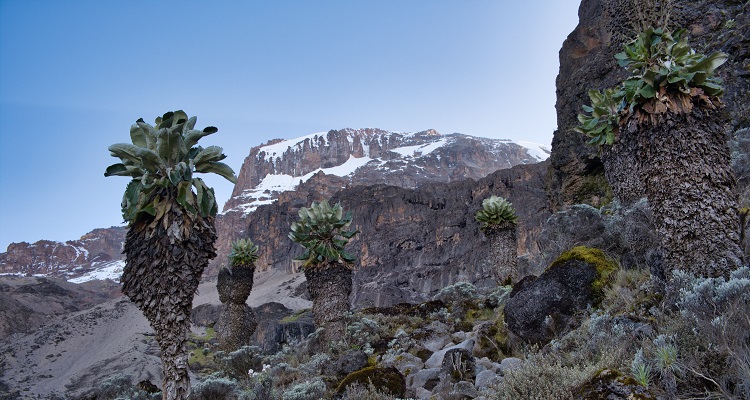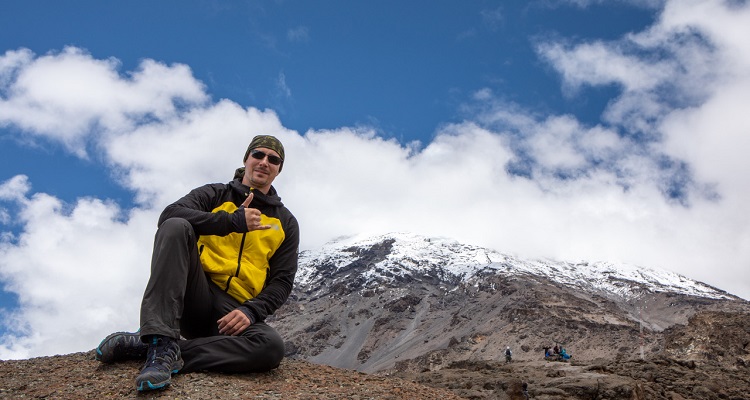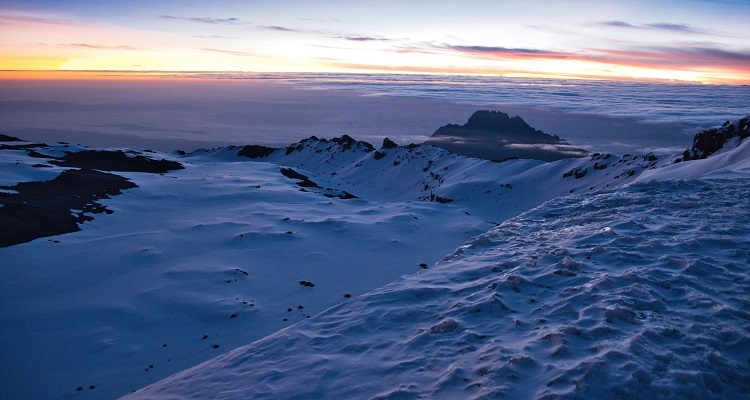7 Days Machame Route - Mount Kilimanjaro Trekking

Description
The Machame route, also known as the Whiskey route, is one of the most scenic routes and the most popular route nowadays. This route is more used than other routes, but more strenuous and involves camping at basic campsites throughout the trek. The start of this route involves a gradual climb through the rain forest, from 1,800 to 3,000 meters. The summit attempt is a long day, involving about 6 – 8 hours walking, most of it during the night.
ITINERARY
-
- Arrival
- DAY 1: Machame Gate to Machame Camp
Altitude : 1800m to 3000m Distance: 11 kilometers
Hiking time: 5 to 7 hours
Habitat: Rain forest - DAY 2: Machame Camp to Shira cave Camp
Altitude:3000m to 3750m
Distance: 5 kilometers
Hiking time: 4 to 6 hours
Habitat: Moorland - DAY 3: Shira cave Camp to Lava Tower to Barranco Camp
Altitude: 3750m to 3940m
Distance: 10 kilometers
Hiking time: 6 to 8 hours
Habitat: Semi-desert - DAY 4: Barranco Hut (3900Mamsl) to Karanga Camp (3995Mamsl)
Altitude : 3940m to 4600m
Distance: 6 Kilometers.
Time: 4 Hours walking.
Zone: Alpine desert. - DAY 5: Karanga Hut (3995Mamsl) to Barafu Camp (4673Mamsl)
Distance: 4 Kilometers.
Time: 3Hours walking.
Zone: Alpine desert zone. - DAY 6:Ascend to the Summit of Uhuru Peak (5895Mamsl)
Distance: 7.5 Kilometers.
Time: 4 Hours.
Zone: Moorland. - DAY 7: Mweka Hut (3100Mamsl) to Mweka Gate (1640Mamsl)
Distance: 10 Kilometers.
Time: 3 Hours walking.
Zone: Rain forest.
Upon arrival at Kilimanjaro International Airport, you will be met and transferred for overnight accommodation at Hotel B&B. Your head guide will meet you for your briefing, gear check and arrange for you equipments .
The drive from Moshi to the Mount Kilimanjaro National Park Gate takes about 50 minutes. The journey passes through the village of Machame which is located on the lower slopes of the mountain. You leave the park gate and walk through the rain forest on a winding trail up a ridge. Lower down, the trail can be muddy and slippery. Gaiters and trekking poles are a good idea here. You will continue a short distance until you reach the Machame Camp.
After breakfast, you will leave the glades of the rain forest and continue on an ascending path, crossing the little valley walking along a steep rocky ridge, covered with heather until the ridge ends. The route now turns west onto a river gorge. Time for rest, dinner and overnight at the Shira campsite.
From the Shira Plateau, you will continue to the east up a ridge, passing the junction towards the peak of Kibo. As you continue, your direction changes to the South East towards the Lava Tower (4600m), called the “Shark’s Tooth.” Shortly after the tower, you will enjoy your lunch and break for acclimatization.
You will continue down to the Barranco Hut at an altitude of 3940m. Here you will rest, enjoy dinner, and overnight. Although you end the day at the almost same elevation as when you started, this day is very important for acclimatization and will help your body prepare for summit day.Start a steep climb up the top Baranco wall which is 4200Mamsl for acclimatization for few minutes. Continue with the trail to reach Karanga Hut 3995Mamsl for the lunch and a long rest. Rest and have refreshments while waiting for dinner.
Trek out of Karanga camp to reach mweka junction 4500Mamsl.Proceed with the hike to join mweka trail which finally leads to Barafu hut. Take as much rest and water upon arrival to prepare your body for the final summit. Dinner and overnight at the campsite. It’s recommended to sleep early by 19:00.
Wake up around 23:00 for adding more warm clothes and headlamps.Leave the camp and start summiting by midnight into the glacial zone.The path leads to Stella point 5756Mamsl.Have time for the sun rise pictures and a short rest for 5 to 10 minutes while having water or hot tea at Stela point.For the climbers who have experienced AMS are advised to start descending, however for those interested can take a round trip along the crater rim to reach Uhuru Peak 5895Mamsl.Proceed by descending from the summit, have a short rest to the base camp again for 2 hours. Have some branch, repark your gears and start to descend to mweka hut 3100M amsl pole pole through mweka route.
After a hot breakfast, continue hiking through the beautiful green forest to arrive at Mweka gate.Take time to show gratitude to the crew by tipping guides, cooks and porters.Get awarded with certificates whereby golden certificates are given to hikers who reached Uhuru peak and green certificates for Stella point hikers.Retreat back to Mweka village for a drive to Moshi town for resting or airport for a flight back at home.
Incudes & Excludes, Map & Trekking Equipments
-
Price includes
>>Private transport to & from Kilimanjaro International Airport to your accommodations in Moshi.
>>2 nights of accommodation in Moshi.
>>Transportation to & from the Kilimanjaro gate
>>Park entry fees,
>>Camping fees.
>>Team Kilimanjaro Rescue fees.
>>18% VAT on tour fees & services
>>4 Season mountain tents
>>Double layered Sleeping Mats
>>Friendly and professional mountain guides, cook and porters.
>>3 hot meals daily while on the mountain.
>>Enough treated & filtered drinking water throughout the trek.
>>Hot water for washing.
>>Fair wages for the mountain crew as approved by the Kilimanjaro National Park Authority (KINAPA), Kilimanjaro Association of Tour Operators (KIATO)
>>Government taxes
>>Portable oxygen tanks & ox meter
>>Emergency first-aid kit.
Price Exclude
>>Lunches, dinners and drinks at your hotel before and after climb.
>>Travel insurance
>>Flights.
>>Laundry (Available at hotel).
>>Personal items and toiletries.
>>Tips for guides, porters and cook .
Technical Clothing:
1 - Waterproof Jacket, breathable with hood - $151 - Insulated Jacket, synthetic or down - $15
1 - Soft Jacket, fleece or soft-shell - $10
2 - Long Sleeve Shirt, light-weight, moisture-wicking fabric - $10
1 - Short Sleeve Shirt, light-weight, moisture-wicking fabric - $10
1 - Waterproof Pants, breathable (side zipper recommended) - $ 5
2 - Hiking Pants - $10
1 - Fleece Pants - $5
1 - Shorts (optional) - $5
1 - Long Underwear, moisture-wicking fabric - $5
3 - Underwear, moisture-wicking fabric recommended - $5
2 - Sport Bra (women)
Equipment
1 - Sleeping Bag, warm, four seasons - $251 - Camp Pillow, inflatable (optional)
1 - Trekking Poles, collapsible (highly recommended) - $10
1 - Head Lamp, with extra batteries - $20
1 - Duffel Bag, 50-90L capacity, for porters to carry your equipment - $15
1 - Daypack, 30-35L capacity, for you to carry your personal gear - $15
Paperwork
Passport – Valid more than 6 months.Visa (applied online but also available at JRO)
Immunization Papers
Insurance Document (That covers 6000m recommended) *
Accessories
1 - Sunglasses or Goggles1 - Backpack Cover, waterproof (optional)
1 - Water Bottle (Nalgene, 32 oz.)
1 - Water Bladder (Camelbak type, 3 liters)
1 - Towel, lightweight, quick-dry (optional)
1 - Pee Bottle, to avoid leaving room/tent at night (recommended)
Head Wear
1 - Brimmed Hat, for sun protection - $51 - Knit Hat, for warmth - $ 5
1 - Balaclava or Buff, for face coverage (optional) - $5
Hand Wear
1 - Gloves, warm (waterproof recommended) - $51 - Gloves, thin - $ 5
Footwear
1 - Hiking Boots, warm, waterproof, broken-in - $201 - Gym Shoes, to wear at camp (optional)
3 - Socks, wool or synthetic - $5
1 - Gaiters, waterproof (optional) - $5
Other Important things:
ToiletriesPrescriptions
Sunscreen
Lip Balm
Insect Repellent, containing DEET
First Aid Kit
Hand Sanitizer
Toilet Paper
Wet Wipes (recommended)
Snacks, light-weight, high calorie, high energy (optional)
Electrolytes, powder or tablets (optional)
Camera, with extra batteries (optional)
Other Trekking Information
So, you've decided to take on the challenge of tackling Africa's highest peak? Next, you need to think about the best time to climb Kilimanjaro, in terms of weather, trekking conditions and popularity. Although it's technically possible to trek Tanzania's Mount Kilimanjaro year round, there are certain months which are characterised by colder weather, more rain and potentially lots of snow on the summit. We generally advise that the best time to climb Kilimanjaro is during the warmest and driest times of year, from December to mid-March and mid-June to the end of October.
What is altitude sickness?
Also called Acute Mountain Sickness (AMS), it is an illness that can affect travellers at high altitudes, usually above 2400m (8000 feet) such as on Mount Kilimanjaro. Altitude sickness is the name given to the physiological and symptomatic reactions of the body to the low oxygen pressure (‘thinner’ air) that occurs at high altitude. When oxygen pressure falls, the body reacts by increasing breathing and heart rate and starts to produce more red blood cells. More red blood cells mean more vehicles to carry oxygen in the blood. The body also increases production of an enzyme that causes the release of oxygen from haemoglobin to the body tissues. Causes of altitude sicknessAMS is caused by reduced air pressure and lower oxygen levels at high altitudes. The faster you climb, the more likely you will get AMS. It is not only the height that matters so much, it is the rate of ascent.
You are at higher risk for AMS if you live near sea level and have had the illness before. Others at risk are those with diseases of the heart/lungs such as chronic bronchitis and asthma, people who are anaemic and those with a history of thromboses. Older people and children are also more susceptible to AMS. Symptoms of altitude sickness
Your symptoms will depend on the rate of your climb and how hard you push yourself. Symptoms usually start 12 – 24 hours after arrival at altitude and can affect the nervous system, lungs, muscles and heart. It is important to remember that reducing the symptoms is not curing the problem. The symptoms of altitude illness are similar to those of a hangover. Initially it starts with a headache, lack of appetite, tiredness and feeling off balance. Many hikers find it difficult to sleep. Then nausea sets in and vomiting starts. Headaches are getting more intense. If you continue, conditions might deteriorate. Sometimes the lack of oxygen can cause the leaking of fluid into the brain and lungs. High Altitude Cerebral Edema (HACE) and High Altitude Pulmonary Edema (HAPE) can develop. Our guides are very experienced with AMS. They will be monitoring all symptoms and will take a safe and well-informed decision on whether to proceed or descend. Most often symptoms will be swiftly relieved with decreasing altitude.
More severe acute mountain sickness includes: Blue skin and lips (cyanosis) and grey or pale complexion
Tight chest
Cough and coughing up blood
Confusion, decreased consciousness or withdrawal from social interaction
Not being able to walk in a straight line or unable to walk.
Prevention of altitude sickness
The slower you go, the better you will acclimatise and the higher you are likely to go without experiencing many symptoms. Recognise early symptoms of AMS and if symptoms increase, descend. Your guide will help you take a decision. The only cure is either acclimatisation or descent.Walk slowly, relax and enjoy.
Drink plenty of fluids while climbing, at least 3 to 4 liters of water per day.
Avoid alcohol when ascending
Talk to your doctor before you attempt to climb Kilimanjaro and ask about the correct preparation, first-aid medication and treatment options for AMS. If you are anaemic, ask your doctor for an iron supplement.
Colds
The risk of altitude sickness will be increased if you are already suffering from respiratory tract infection such as a cold. If you have the flu, do not travel until you are fully recovered. Both colds and the flu are caused by viruses and anti-biotics will not be effective as it is used against bacterial infections.Acute upper respiratory tract infections include pharyngitis/tonsillitis and laryngitis. Complications may lead to sinusitis, ear infection and sometimes bronchitis which can all be exacerbated by high altitude.
Some research has shown that restrained exercise might not change the severity and duration of the illness, but the intensity of a Kilimanjaro hike will jeopardise your recovery. Getting plenty of sleep is advised as sleep deprivation is associated with increased receptiveness to infection.
- Duration7 Days, 6 night
- Group SizePrice(Us $)
- 1 Person $ 2500
- 2-6 People$ 2000
- 7-12 People$ 1800


